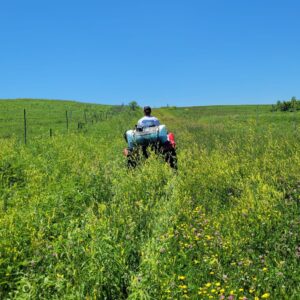Watershed Conservation Corps Fights Sericea Lespedeza at Dunn Ranch
 Watershed Conservation Corps went to The Nature Conservancy’s Dunn Ranch to help manage the terribly invasive Sericea Lespedeza for the third season this summer. Dunn Ranch offers 3,258 acres of gorgeous and diverse prairie, some of which is remnant- meaning it has never been plowed. The property is continually grazed by a herd of Bison, which do their part in taking care of the property. Each year our crews are excited at the opportunity to help manage the ranch.
Watershed Conservation Corps went to The Nature Conservancy’s Dunn Ranch to help manage the terribly invasive Sericea Lespedeza for the third season this summer. Dunn Ranch offers 3,258 acres of gorgeous and diverse prairie, some of which is remnant- meaning it has never been plowed. The property is continually grazed by a herd of Bison, which do their part in taking care of the property. Each year our crews are excited at the opportunity to help manage the ranch.
Why Fight the Invasive?
You may wonder how keeping invasive species like Sericea Lespedeza at bay helps our watersheds. Here are a handful of reasons that the Watershed Conservation Corps works to manage invasive species in our region:
Reduced Competition: Invasive species often outcompete native vegetation, leading to monocultures that don’t support diverse ecosystems. By controlling invasives, native plants can thrive, which can improve water retention and reduce erosion.
Erosion Control: Some invasive plants have shallow roots that do not stabilize soil well. When removed, native plants with deeper root systems can prevent erosion, reducing sedimentation in water bodies.
Nutrient Balance: Invasive species sometimes alter nutrient cycles, leading to imbalances that can degrade water quality. Restoring native vegetation helps maintain natural nutrient cycles and can improve water quality by reducing nutrient runoff.
Habitat Restoration: Many invasive species degrade habitats for native wildlife. Restoring native plant communities can improve habitat quality.
Biodiversity: Healthy native ecosystems support greater biodiversity, including beneficial species like pollinators and natural predators of pests.
The Culprit...


